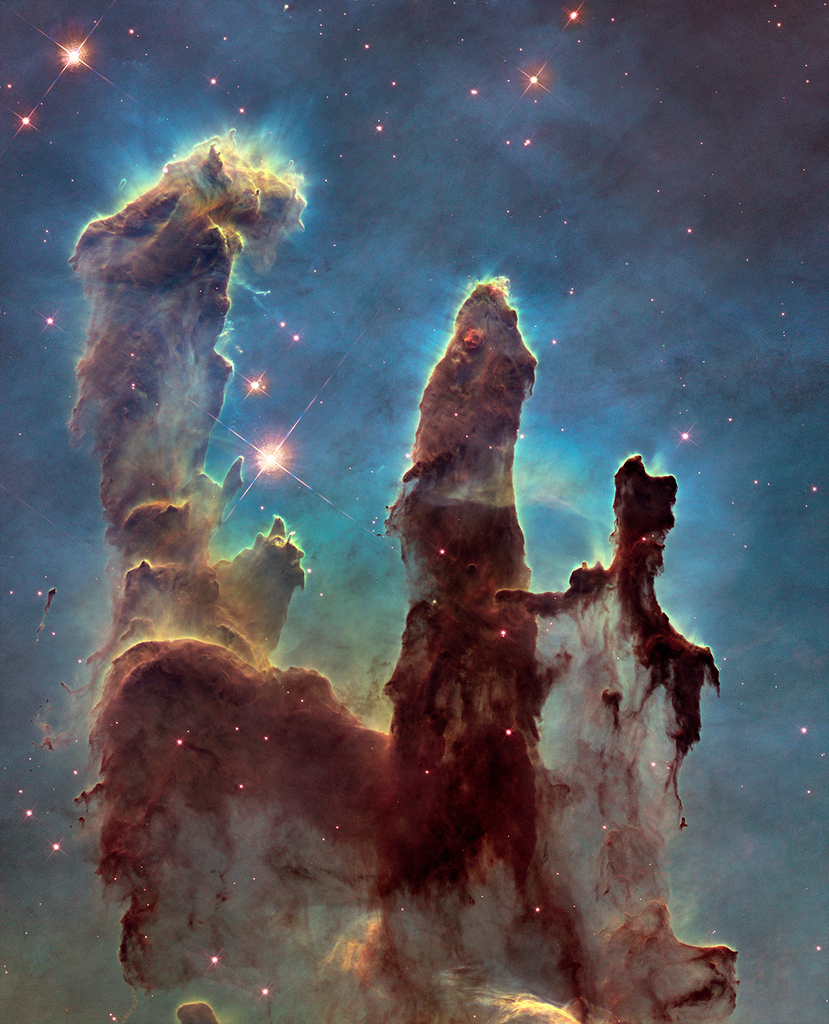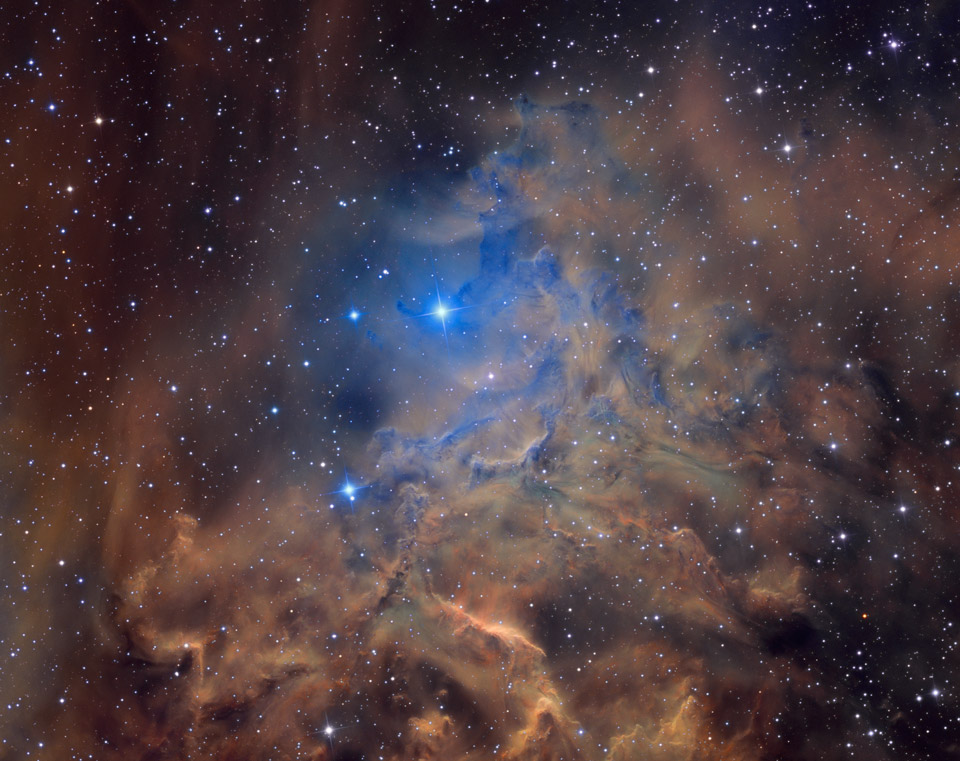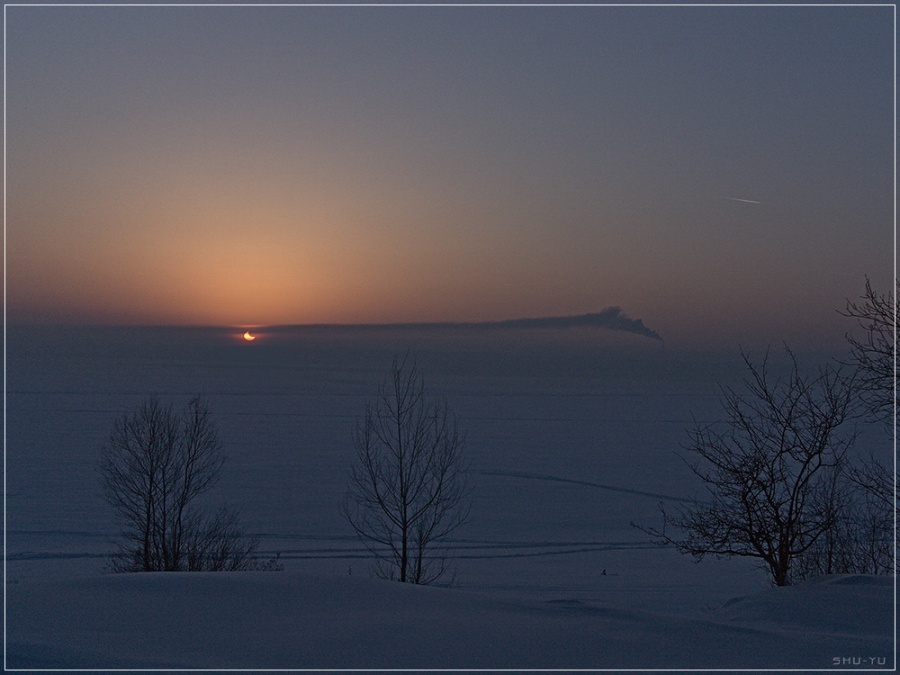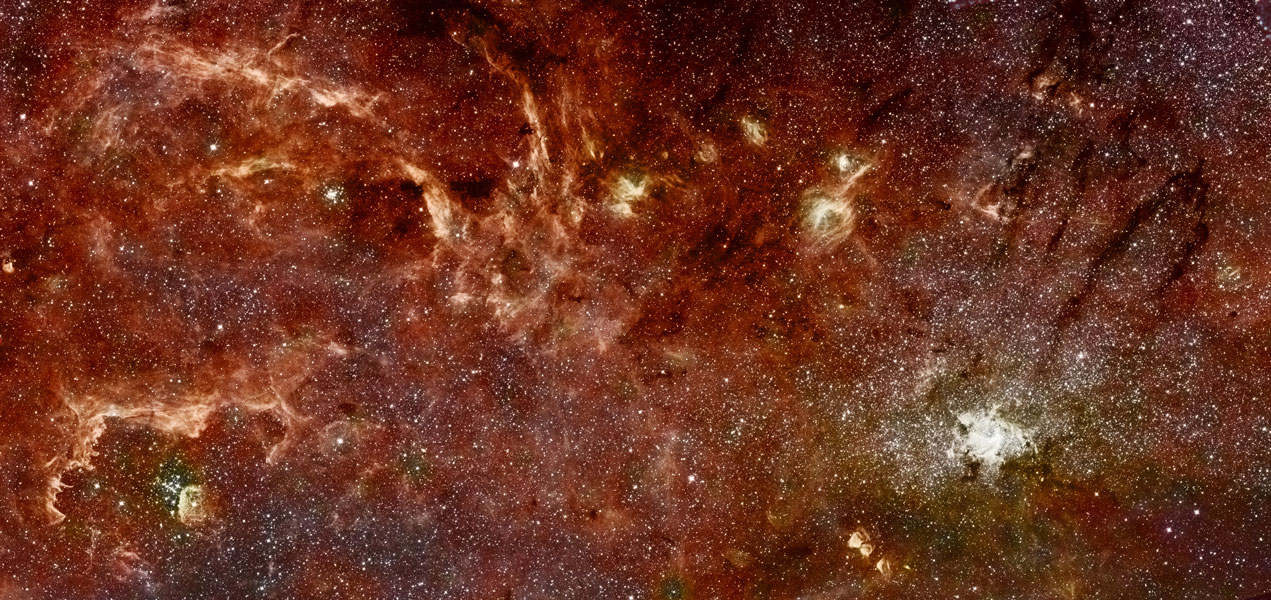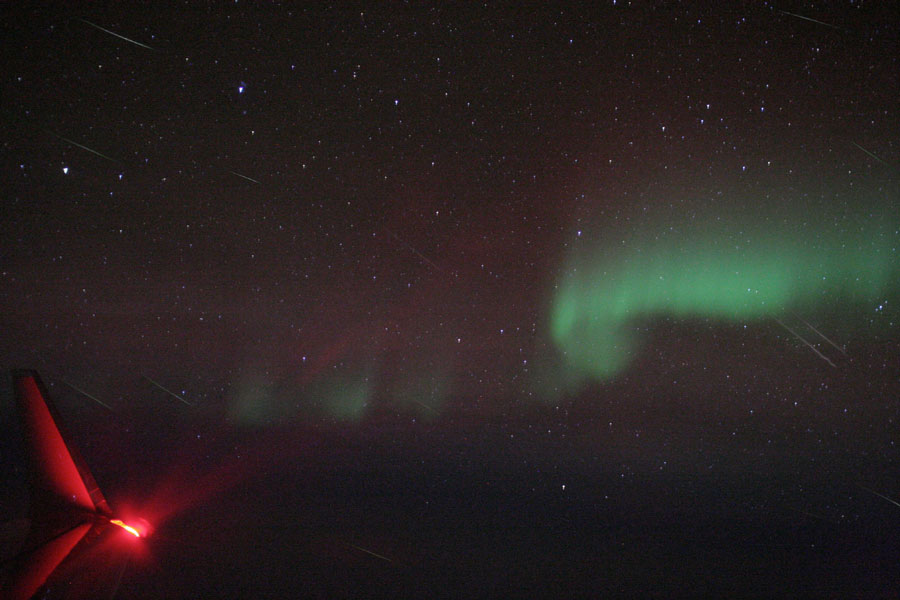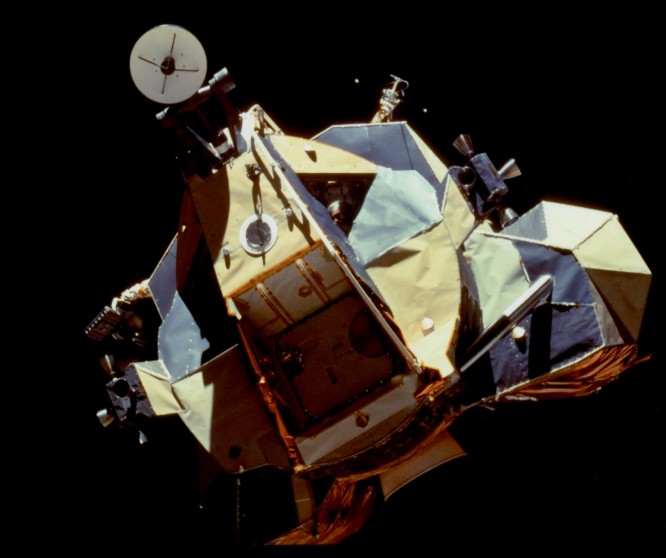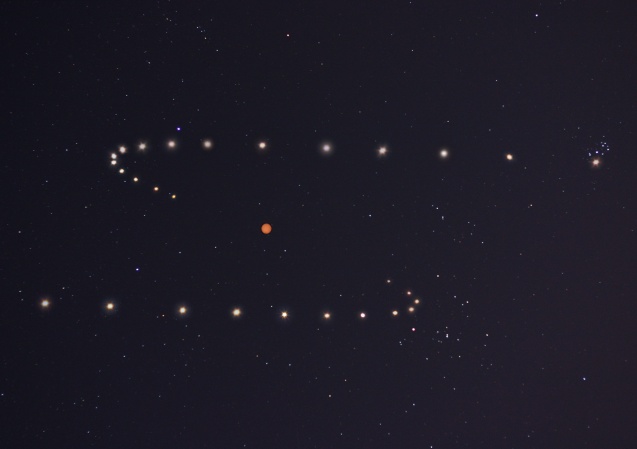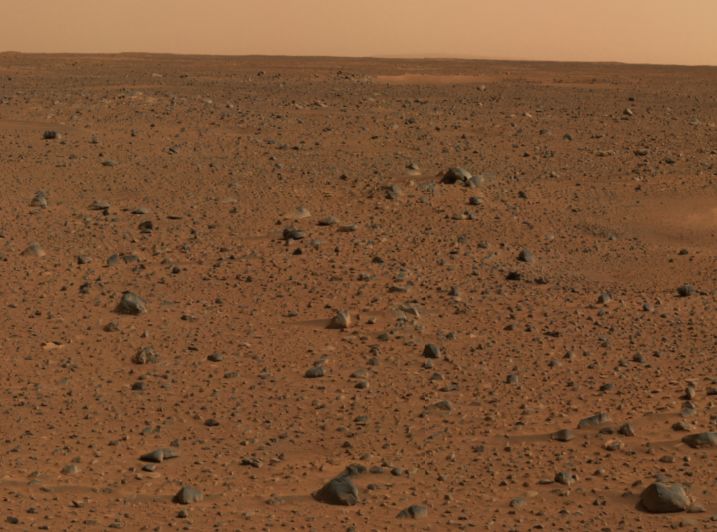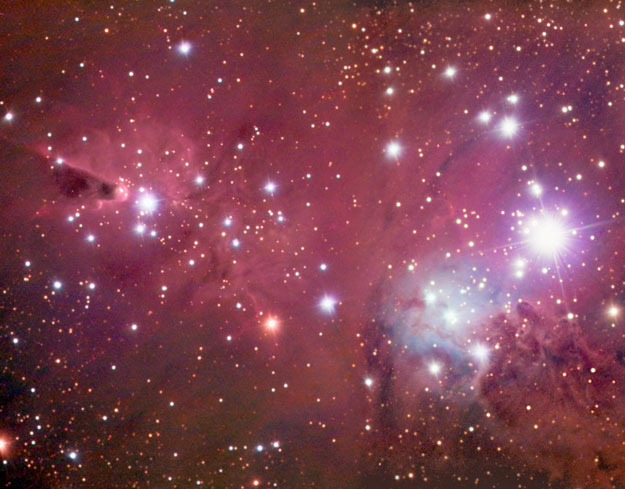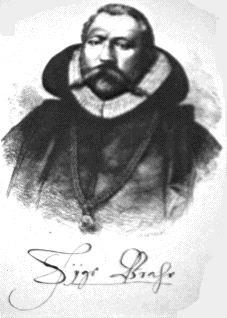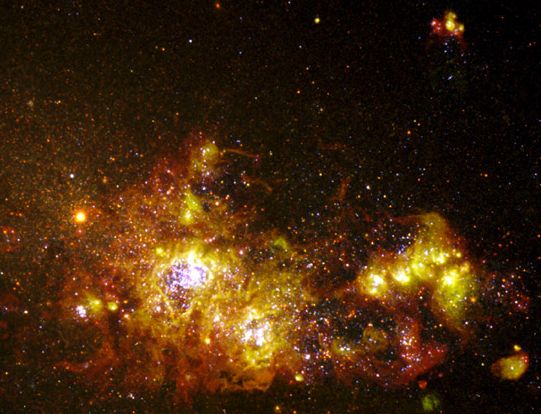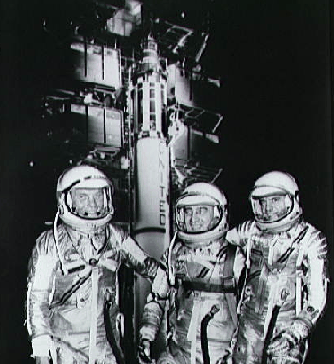| << Previous | Index | Next >> |
2015 To celebrate 25 years (1990-2015) of exploring the Universe from low Earth orbit, the Hubble Space Telescope's cameras were used to revisit its most iconic image. The result is this sharper, wider view of the region dubbed the Pillars of Creation, first imaged by Hubble in 1995. Stars are forming deep inside the towering structures. The light-years long columns of cold gas and dust are some 6,500 light-years distant in M16, the Eagle Nebula, toward the constellation Serpens. Sculpted and eroded by the energetic ultraviolet light and powerful winds from M16's cluster of young, massive stars, the cosmic pillars themselves are destined for destruction. But the turbulent environment of star formation within M16, whose spectacular details are captured in this Hubble visible-light snapshot, is likely similar to the environment that formed our own Sun.
2014 M7 is one of the most prominent open clusters of stars on the sky. The cluster, dominated by bright blue stars, can be seen with the naked eye in a dark sky in the tail of the constellation of the Scorpion (Scorpius). M7 contains about 100 stars in total, is about 200 million years old, spans 25 light-years across, and lies about 1000 light-years away. The above deep image, taken last June from Hungary through a small telescope, combines over 60 two-minute exposures. The M7 star cluster has been known since ancient times, being noted by Ptolemy in the year 130 AD. Also visible are a dark dust cloud and literally millions of unrelated stars towards the Galactic center.
2013 AE Aurigae is called the flaming star. The surrounding nebula IC 405 is named the Flaming Star Nebula and the region seems to harbor smoke, but there is no fire. Fire, typically defined as the rapid molecular acquisition of oxygen, happens only when sufficient oxygen is present and is not important in such high-energy, low-oxygen environments. The material that appears as smoke is mostly interstellar hydrogen, but does contain smoke-like dark filaments of carbon-rich dust grains. The bright star AE Aurigae, visible near the nebula center, is so hot it is blue, emitting light so energetic it knocks electrons away from atoms in the surrounding gas. When an atom recaptures an electron, light is emitted creating the surrounding emission nebula. In this cosmic portrait, the Flaming Star nebula lies about 1,500 light years distant, spans about 5 light years, and is visible with a small telescope toward the constellation of the Charioteer (Auriga).
2012 Galaxies are fascinating not only for what is visible, but for what is invisible. Grand spiral galaxy NGC 1232, captured in detail by one of the new Very Large Telescopes, is a good example. The visible is dominated by millions of bright stars and dark dust, caught up in a gravitational swirl of spiral arms revolving about the center. Open clusters containing bright blue stars can be seen sprinkled along these spiral arms, while dark lanes of dense interstellar dust can be seen sprinkled between them. Less visible, but detectable, are billions of dim normal stars and vast tracts of interstellar gas, together wielding such high mass that they dominate the dynamics of the inner galaxy. Invisible are even greater amounts of matter in a form we don't yet know - pervasive dark matter needed to explain the motions of the visible in the outer galaxy.
2011 Seen from central and northern Asia, the Sun and New Moon set together on January 4, in a partial solar eclipse. Close to its maximum phase, the eclipse is captured near the moment of sunset in this wintry scene from the bank of the Berd River near Novosibirsk, Siberia, Russia. An evocative view in fading light, the picture looks toward the western horizon across a snowy, frozen landscape. Along with offset Sun and Moon, the dimly lit sky includes an industrial smoke plume and airplane contrail.
2010 A satellite galaxy of our Milky Way, the Small Magellanic Cloud is wonder of the southern sky, named for 16th century Portuguese circumnavigator Ferdinand Magellan. Some 200,000 light-years distant in the constellation Tucana, the small irregular galaxy's stars, gas, and dust that lie along a bar and extended "wing", are familiar in images from optical telescopes. But the galaxy also has a tail. Explored in this false-color, infrared mosaic from the Spitzer Space Telescope, the tail extends to the right of the more familiar bar and wing. Likely stripped from the galaxy by gravitational tides, the tail contains mostly gas, dust, and newly formed stars. Two clusters of newly formed stars, warming their surrounding natal dust clouds, are seen in the tail as red spots.
2009
2008 Where do meteor showers originate? To help answer this question, astronomers studied in some detail the Quadrantid meteor shower that occurred over this past weekend. In particular, astronomers with specialized cameras flew as part of the Quadrantid's Multi-Instrument Aircraft Campaign (MAC) aboard a Gulfstream V aircraft above northern Canada over the past few days and studied the Quadrantid meteor shower in unprecedented detail. Pictured above is a composite image combining many short exposures. Visible in the image are the wingtip of the airplane reflecting a red beacon on the left, green aurora most prominent on the image right, and numerous meteor streaks throughout. Preliminary indications are that the meteor stream is quite stable in time but variable in meteor abundance. Over 100 meteors per hour were visible at the peak from the MAC aircraft. Meteor data from around the world will continue to be analyzed to try to verify Peter Jenniskens's recent hypothesis that minor planet 2003 EH1 is an intermittently active comet and the parent body of the annual Quadrantid meteor shower.
2007 What's causing those odd rings in supernova 1987A? In 1987, the brightest supernova in recent history occurred in the Large Magellanic Clouds. At the center of the picture is an object central to the remains of the violent stellar explosion. When the Hubble Space Telescope was pointed at the supernova remnant in 1994, however, the existence of curious rings was confirmed. The origins of these rings still remains a mystery. Speculation into the cause of the rings includes beamed jets emanating from a dense star left over from the supernova, and a superposition of two stellar winds ionized by the supernova explosion.
2006 Awkward and angular looking, Apollo 17's lunar module Challenger was designed for flight in the vacuum of space. This picture from command module America, shows Challenger's ascent stage in lunar orbit. Small reaction control thrusters are at the sides of the moonship with the bell of the ascent rocket engine underneath. The hatch allowing access to the lunar surface is seen at the front, with a round radar antenna at the top. Mission commander Gene Cernan is just visible through the dark, triangular window. This spaceship performed gracefully, landing on the Moon and returning the Apollo astronauts to the orbiting command module in December of 1972. So where is Challenger now? Its descent stage remains at the Apollo 17 landing site, Taurus-Littrow. The ascent stage was intentionally crashed nearby after being jettisoned from the command module prior to the astronauts' return to planet Earth. Apollo 17's mission was the sixth and last time astronauts have landed on the Moon.
2005 Planet Venus traced out this S shape in Earth's sky during 2004. Following the second planet from the Sun in a series of 29 images recorded from April 3rd through August 7th (top right to bottom left) of that year, astronomer Tunc Tezel constructed this composite illustrating the wandering planet's path against the background stars. The series reveals Venus' apparent retrograde motion transporting it from a brilliant evening star to morning's celestial beacon. Of course, in 2004, after sinking into the evening twilight but before rising above the predawn horizon, Venus was seen in silhouette against the Sun (near center) - the first transit of Venus since 1882. The next time Venus will wander across the solar disk is in 2012.
2004 Rocks are strewn across the broad, flat Gusev crater floor in this sharp color picture from NASA's Spirit rover. Recorded by the rover's panoramic camera, the picture is part of Spirit's first color image of Mars - the highest resolution picture yet taken on the surface of another planet. Already revealing alluring and perplexing details of an apparently windswept plain thought to be an ancient lake bed, this stunning view represents only a small fraction of the color image data mission scientists expect to be transmitted in the coming days. As the robotic Spirit rover is preparing to stand up, roll off the lander, and explore the geology of the crater floor, NASA has announced plans to rename the landing site the Columbia Memorial Station in honor of the astronauts lost in the Columbia space shuttle accident.
2003 Open cluster M38 can be seen with binoculars toward the constellation of Auriga. M38 is considered an intermediately rich open cluster of stars, each of which is about 200 million years old. Located in the disk of our Milky Way galaxy, M38 is still young enough to house many bright blue stars, although it's brightest star is a yellow giant shining 900 times brighter than our Sun. The cluster spans roughly 25 light-years and lies about 4000 light-years away. M38, pictured above, is found only about 2.5 degrees northwest of open cluster M36. Loosely bound by gravity, open clusters spread out over time as they orbit the galactic center and their member stars slowly escape.
2002 Sometimes the simplest shapes are the hardest to explain. For example, the origin of the mysterious cone-shaped region seen on the far left remains a mystery. The interstellar formation, dubbed the Cone Nebula, is located about 2700 light years away. Other features in the image include red emission from diffuse interstellar hydrogen, wispy filaments of dark dust, and bright star S Monocerotis, visible on the far right. Blue reflection nebulae surround the brighter stars. The dark Cone Nebula region clearly contains much dust which blocks light from the emission nebula and open cluster NGC 2264 behind it. One hypothesis holds that the Cone Nebula is formed by wind particles from an energetic source blowing past the Bok Globule at the head of the cone.
2001 Tycho Brahe was the most meticulous astronomical observer of his time. Brahe, who lived between 1546 and 1601, set out to solve the day's most pressing astronomical problem: to determine whether the Earth or the Sun was at the center of the Solar System. To do this Brahe and his assistants created the first major astronomical observatory where they devised and used the most accurate pre-telescopic astronomical instruments. Tycho Brahe thus compiled tables of precise measurements of the positions and brightnesses of planets and stars. Brahe never solved the Solar System problem himself - but left data so impressively accurate his assistant Johannes Kepler was able to develop definitive laws. Brahe is also remembered for witnessing a supernova in 1572, showing that the Great Comet of 1577 was not an atmospheric phenomena, and for his metal nose.
2000 Dazzling displays of star formation abound across the face of galaxy NGC 4214, a mere 13 million light-years away in the northern constellation Canes Venatici. While this 1997 Hubble Space Telescope image shows the numerous faint, older stars of NGC 4214, the most eye-catching features are the galaxy's bright young star clusters surrounded by fluorescent gas clouds. Sculpted into bubbles and filamentary shapes by energetic explosions and stellar winds from massive cluster stars, the clouds fluoresce in the intense stellar ultraviolet radiation. The colorful spectacle of massive young star forming clusters and distinguished presence of a fainter, older stellar population indicate that NGC 4214 has experienced star formation episodes spanning billions of years.
1999 Except for the Rings of Saturn, The Ring Nebula (M57) is probably the most famous celestial band. This planetary nebula's simple, graceful appearance is thought to be due to perspective -- our view from planet Earth looking straight into what is actually a barrel-shaped cloud of gas shrugged off by a dying central star. Astronomers of the Hubble Heritage Project produced this strikingly sharp image from Space Telescope observations using natural appearing colors to indicate the temperature of the stellar gas shroud. Hot blue gas near the energizing central star gives way to progressively cooler green and yellow gas at greater distances with the coolest red gas along the outer boundary. Dark, elongated structures can also be seen near the nebula's edge. The Ring Nebula is about one light-year across and 2,000 light-years away in the northern constellation Lyra.
1998 Do you recognize the Earth's Moon when you see it? The crazy, patchwork appearance of this false color image makes this nearly full view of our Moon's familiar nearside look very strange. The image was taken in 1992 by the Galileo spacecraft enroute to Jupiter. The Sea of Tranquillity (Mare Tranquillitatis) is the blue area at right, the Ocean of Storms (Oceanus Procellarum) is the extensive blue and orange area on the left, and white lines radiate from the crater Tycho at bottom center. Three filters were used to make three separate exposures, combined in an exaggerated color scheme to emphasize composition differences - blue hues reveal titanium rich areas while orange and purple colors show regions relatively poor in titanium and iron. NASA soon plans to conduct an extensive remote exploration of the lunar surface, including a search for water ice near the lunar South Pole, with the Lunar Prospector spacecraft.
1997 The Sun is leaking. In fact, it is gushing: particles stream away from the Sun at hundreds of kilometers per second. Some of these particles strike the Earth and cause aurora. Most particles, however, either surround the Sun as a huge solar corona or glide into interstellar space as the solar wind. Don't worry about the Sun totally evaporating - it loses too little mass to have any lasting effect. The above false-color picture was taken with the Large Angle and Spectrometric Coronograph on board the SOlar and Heliospheric Observatory (SOHO). This instruments blocks out the central solar disk so it can image the regions surrounding the Sun. The large streamers visible are typical. Where these charged ions get their enormous streaming energy is still a mystery!
1996 Space suited project Mercury astronauts John H. Glenn, Virgil I. Grissom, and Alan B. Shepard Jr. (left to right) are pictured here posing in front of a Redstone rocket in this 1961 NASA publicity photo. Project Mercury was the first U.S. program designed to put humans in space. It resulted in 6 manned flights using one-man capsules and Redstone and Atlas rockets. Shortly after the first U.S. manned flight on May 5, 1961, a suborbital flight piloted by Alan Shepard, President Kennedy announced the goal of a manned lunar landing by 1970. This goal was achieved by NASA's Apollo program and Shepard himself walked on the moon as a member of the Apollo 14 mission.
| << Previous | Index | Next >> |
